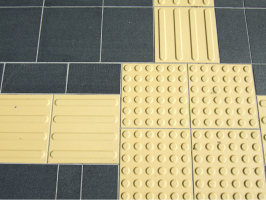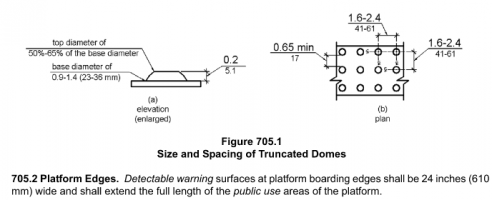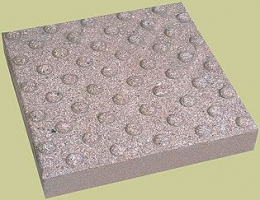-
Welcome to The Building Code Forum
Your premier resource for building code knowledge.
This forum remains free to the public thanks to the generous support of our Sawhorse Members and Corporate Sponsors. Their contributions help keep this community thriving and accessible.
Want enhanced access to expert discussions and exclusive features? Learn more about the benefits here.
Ready to upgrade? Log in and upgrade now.
You are using an out of date browser. It may not display this or other websites correctly.
You should upgrade or use an alternative browser.
You should upgrade or use an alternative browser.
Sidewalk detectible surfaces
- Thread starter e hilton
- Start date
Paul Sweet
SAWHORSE
As far as I know they are still required. However, I've probably seen more installed where they shouldn't be than installed properly.
north star
MODERATOR
- Joined
- Oct 19, 2009
- Messages
- 4,596
+ + % + +
" Someone told me those raised dot detectible surfaces in sidewalks are no longer ADA compliant. It was a comment without backup. Is that correct? ".
FWIW, ...they're truncated domes.
+ + % + +
mark handler
SAWHORSE
Mr. Inspector
SAWHORSE
They are required in the ICC/ANSI A117.1-2006 sections 406.12, 406.13 and 406.14 and to comply with 705.5
Yikes
SAWHORSE
California still requires them at platform edges, curb ramps, islands or cut-through medians, bus stops, and "hazardous vehicular areas", reflecting pools and track crossings (CBC 11B-705.1.2). ADA only requires them at boarding platforms (see below).
Wheelchair and walker users hate them for the obvious bumpy reasons. They are also too tall to be placed within a required "level and clear" door clearance or ADA parking stall area.
Anecdotally, I know of no vision impaired person who uses them or relies on them other than at transit platforms. I have a friend who has been blind for 20 years, and he says at the training schools they teach you to ignore / not rely on them, because they are incorrectly placed and / or over-used so many times that they can't be trusted to convey meaningful information. Many times you can't tell whether you are stepping into, or out of, a hazardous area.
Pardon my cynicism, but the only people I know who "like" them are California serial litigants.
Other countries such as Japan design with tactile paving as a directional guide/pattern to follow, not as a border warning:

Where required in ADA:

What they look like:


Wheelchair and walker users hate them for the obvious bumpy reasons. They are also too tall to be placed within a required "level and clear" door clearance or ADA parking stall area.
Anecdotally, I know of no vision impaired person who uses them or relies on them other than at transit platforms. I have a friend who has been blind for 20 years, and he says at the training schools they teach you to ignore / not rely on them, because they are incorrectly placed and / or over-used so many times that they can't be trusted to convey meaningful information. Many times you can't tell whether you are stepping into, or out of, a hazardous area.
Pardon my cynicism, but the only people I know who "like" them are California serial litigants.
Other countries such as Japan design with tactile paving as a directional guide/pattern to follow, not as a border warning:

Where required in ADA:

What they look like:


Mr. Inspector
SAWHORSE
Yikes, do the y tell them not to rely on the braille exit signs too? They get taken down and missing a lot.
mark handler
SAWHORSE
The Department of Justice (DOJ) is the lead agency that oversees the Americans with Disabilities Act (ADA)(1990). The U.S. Access Board developed the minimum design standards for complying with the ADA. The Department of Transportation is a designated agency responsible for enforcing the standards and implementing regulations of the ADA's Title II (State and Local Government Services). The Federal Highway Administration (FHWA) is the enforcement authority for overseeing pedestrian discrimination issues under the Title II implementing regulations.Mark, any history to explain the change?
Detectable warnings were required in 1991 by the Americans with Disabilities Act Accessible Guideline (ADAAG) (regulatory standards) for hazardous vehicular ways, transit platform edges, and curb ramps. A suspension was placed on requiring detectable warnings at curb ramps and hazardous vehicular ways, but not for transit platform edges. The reason for the suspension was to conduct research on the performance of their detectability. The DOJ continued the suspension through July 26, 2001, which allowed 10 years for conducting research. The research determined that other designs used in place of truncated domes such as grooves, striations, and exposed aggregate, were not detectable in the sidewalk and roadway environment because of the similarities to other surface textures and defects. Truncated domes have a unique design that can be detected underfoot and with a cane, and other surfaces are not considered ADA equivalent and therefore do not comply with the ADA requirements.
The DOJ had the option of allowing the suspension to expire on July 26, 2001 or publish a Federal Register Notice to continue the suspension. They decided to let the suspension expire. Consequently, since July 26, 2001 detectable warnings are again required. FHWA is obligated to enforce the requirements, and State and local governments are required to apply the minimum design standards when constructing and altering pedestrian facilities, though we encourage higher than minimum standards where possible.
The original ADA design standard for truncated domes is found in ADAAG (4.29.2). After the research was conducted, a new design recommendation was made for the dimension and placement of the domes on curb ramps. Both FHWA and the U.S. Access Board are encouraging the use of the new design over the original. Information on the recommended design and other useful information are included in the attachment
mark handler
SAWHORSE
More Changes, Alterations were made under the 2010 ADASAD
bill1952
SAWHORSE
This reminds me of an Access Board public hearing and representatives of two separate organizations each representing people with the same disability were at polar opposites on a requirement. Just like code changes where someone "thinks" - but without peer reviewed research or creditable evidence - a specific change is needed and is passionate about it.
Yikes
SAWHORSE
They generally rely on braille signs.Yikes, do the y tell them not to rely on the braille exit signs too? They get taken down and missing a lot.
There's a big difference between a sign that is missing vs. a sign that is present but conveys the wrong information, so it's not the same situation.
A misplaced tactile warning (or more likely, a series/sequence of tactile warnings) could incorrectly lead someone to think they are leaving a hazardous area, when in fact they are entering a hazardous area.
A rough braille analogy to this would be if the visible letters on a sign said " NOT AN EXIT" but the Braille letters said "EXIT".
mtlogcabin
SAWHORSE
During a final inspection with a young first time job superintendent I ran my finger across the braille on the men's room sign and looked at him with a very serious look and said "that's misspelled". The look on his face was priceless.
Mr. Inspector
SAWHORSE
Done that myself. But I wouldn't know since I can't read braille.During a final inspection with a young first time job superintendent I ran my finger across the braille on the men's room sign and looked at him with a very serious look and said "that's misspelled". The look on his face was priceless.
It's an "international " code but does the code require English?
Here's what the google gods have deemed for us lowly mortals.
"Braille is a system of raised dots that can be read with the fingers by people who are blind or who have low vision. ... Braille is not a language. Rather, it is a code by which many languages—such as English, Spanish, Arabic, Chinese, and dozens of others—may be written and read."
"Braille is a system of raised dots that can be read with the fingers by people who are blind or who have low vision. ... Braille is not a language. Rather, it is a code by which many languages—such as English, Spanish, Arabic, Chinese, and dozens of others—may be written and read."
Paul Sweet
SAWHORSE
The Public Right-of Way Accessibility Guidelines (PROWAG) require them:
R208.1 Where Required. Detectable warning surfaces complying with R305 shall be provided at the
following locations on pedestrian access routes and at transit stops:
1. Curb ramps and blended transitions at pedestrian street crossings;
2. Pedestrian refuge islands;
3. Pedestrian at-grade rail crossings not located within a street or highway;
4. Boarding platforms at transit stops for buses and rail vehicles where the edges of the boarding
platform are not protected by screens or guards; and
5. Boarding and alighting areas at sidewalk or street level transit stops for rail vehicles where the
side of the boarding and alighting areas facing the railvehicles is not protected by screens or guards
R101 Purpose says:
"Compliance with this document is mandatory when required by regulations issued by federal agencies that include accessibility standards for the design, construction, and alteration of pedestrian facilities in the public right-of-way."
Virginia requires state facilities to follow PROWAG for sitework that isn't in the VDOT right-of-way or otherwise regulated by ADASAD. Some other jurisdications may also have adopted them.
R208.1 Where Required. Detectable warning surfaces complying with R305 shall be provided at the
following locations on pedestrian access routes and at transit stops:
1. Curb ramps and blended transitions at pedestrian street crossings;
2. Pedestrian refuge islands;
3. Pedestrian at-grade rail crossings not located within a street or highway;
4. Boarding platforms at transit stops for buses and rail vehicles where the edges of the boarding
platform are not protected by screens or guards; and
5. Boarding and alighting areas at sidewalk or street level transit stops for rail vehicles where the
side of the boarding and alighting areas facing the railvehicles is not protected by screens or guards
R101 Purpose says:
"Compliance with this document is mandatory when required by regulations issued by federal agencies that include accessibility standards for the design, construction, and alteration of pedestrian facilities in the public right-of-way."
Virginia requires state facilities to follow PROWAG for sitework that isn't in the VDOT right-of-way or otherwise regulated by ADASAD. Some other jurisdications may also have adopted them.
Jean Tessmer-HI
REGISTERED
Detectable warnings are not required on private commercial projects. Detectable warnings were never vetted or tested for safety and have caused permanent severe disability to ambulatory who have tripped and fallen on the domed surface. Doctor said it was like someone struck them on their forehead with a ball paean hammer. They were never tested for safety they were only tested be being detectable with cane and came from the federal government. They did not come from a recognized standard that rigorously tested for years to work with the severely disabled and able body individuals. The only tactile surface approved by the ANSI Standard is the flat grooved surface and even that was not allowed outdoors. They are hazardous.
Jean Tessmer-HI
REGISTERED
If you need to know where they are required you can call the US Accesss Board who developed the 2010 DOJ ADA standard. Here is an excerpt from the email response.
Under the current ADA Standards, detectable warnings are required along the edge of open boarding platforms in rail stations (810.5.2) and on curb ramps (406.8) in transit facilities. The Federal Highway Administration also requires detectable warnings in projects it funds.
We are finalizing the ADA Public Rights-of-Way Accessibility Guidelines (PROWAG) which will address detectable warnings on curb ramps, blended transitions, and other locations along public streets and sidewalks. At this time, we recommend that the proposed PROWAG be used as a resource in providing detectable warnings on curb ramps at public streets and sidewalks. The ADA Standards require detectable warnings on curb ramps at transit facilities subject to DOT’s Standards but not to other types of facilities on sites.
Further information is posted on our website: https://www.access-board.gov/prowag/other/dw-update.html.
Dave Yanchulis
Under the current ADA Standards, detectable warnings are required along the edge of open boarding platforms in rail stations (810.5.2) and on curb ramps (406.8) in transit facilities. The Federal Highway Administration also requires detectable warnings in projects it funds.
We are finalizing the ADA Public Rights-of-Way Accessibility Guidelines (PROWAG) which will address detectable warnings on curb ramps, blended transitions, and other locations along public streets and sidewalks. At this time, we recommend that the proposed PROWAG be used as a resource in providing detectable warnings on curb ramps at public streets and sidewalks. The ADA Standards require detectable warnings on curb ramps at transit facilities subject to DOT’s Standards but not to other types of facilities on sites.
Further information is posted on our website: https://www.access-board.gov/prowag/other/dw-update.html.
Dave Yanchulis


